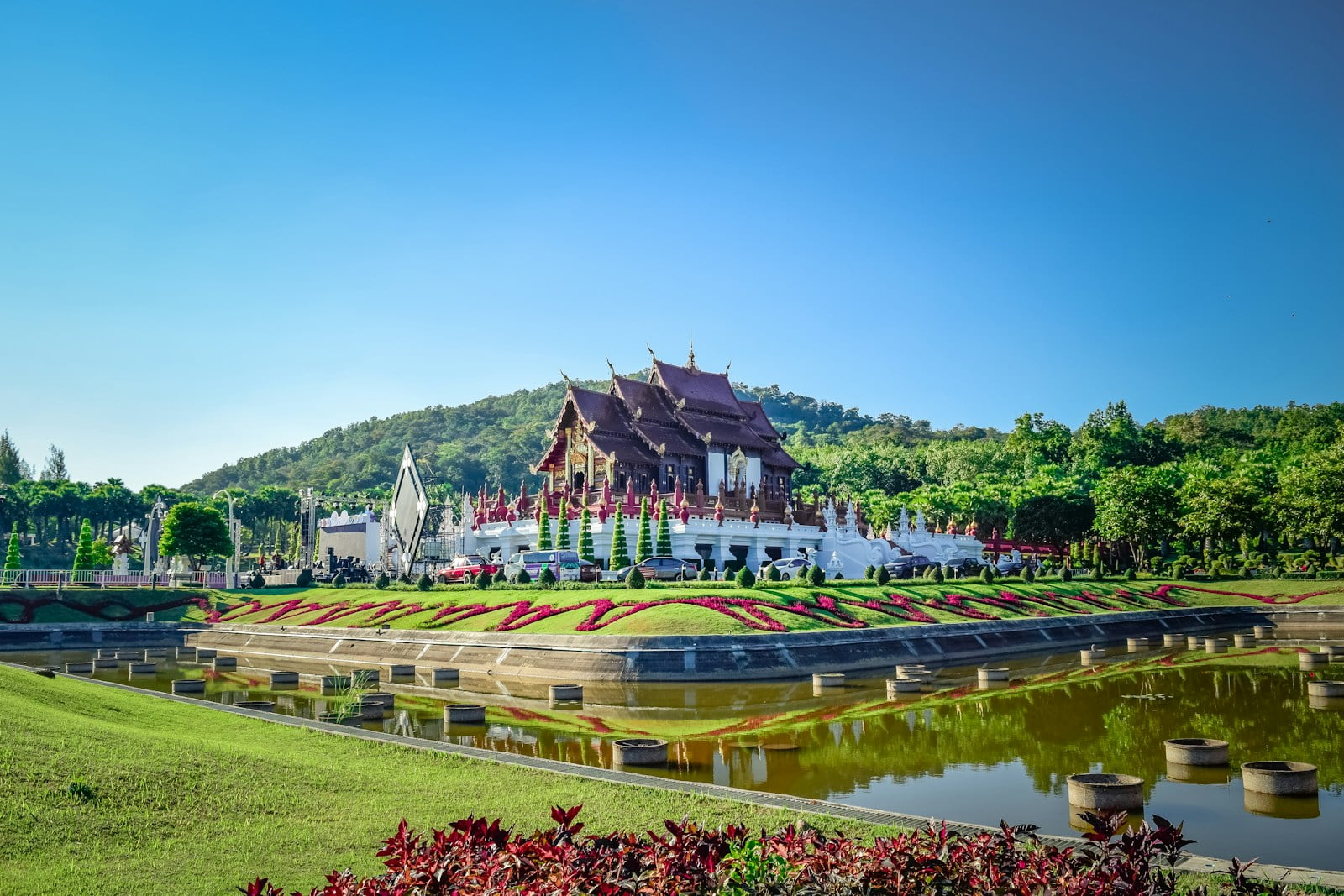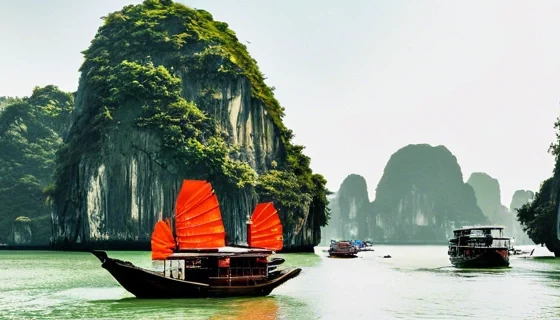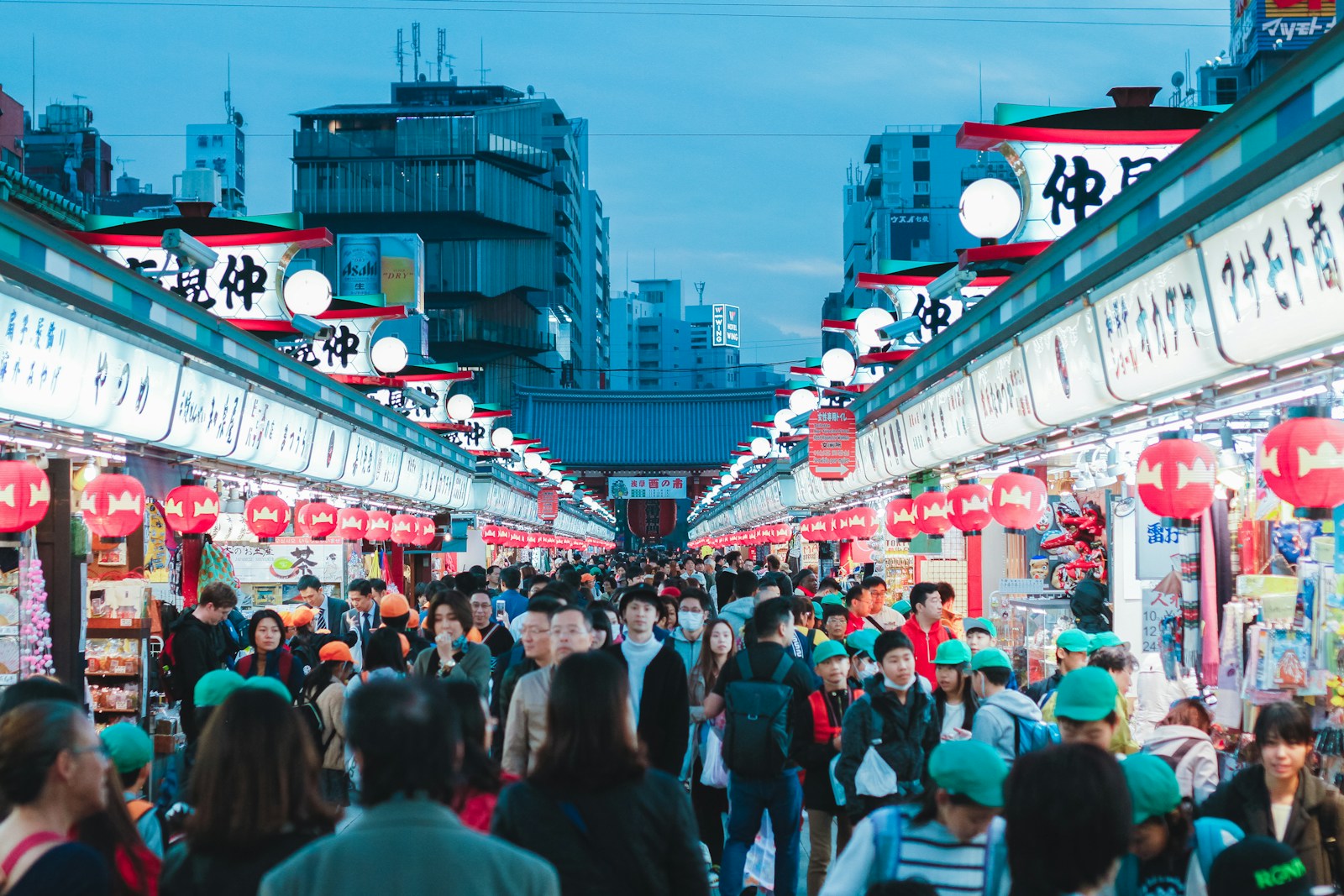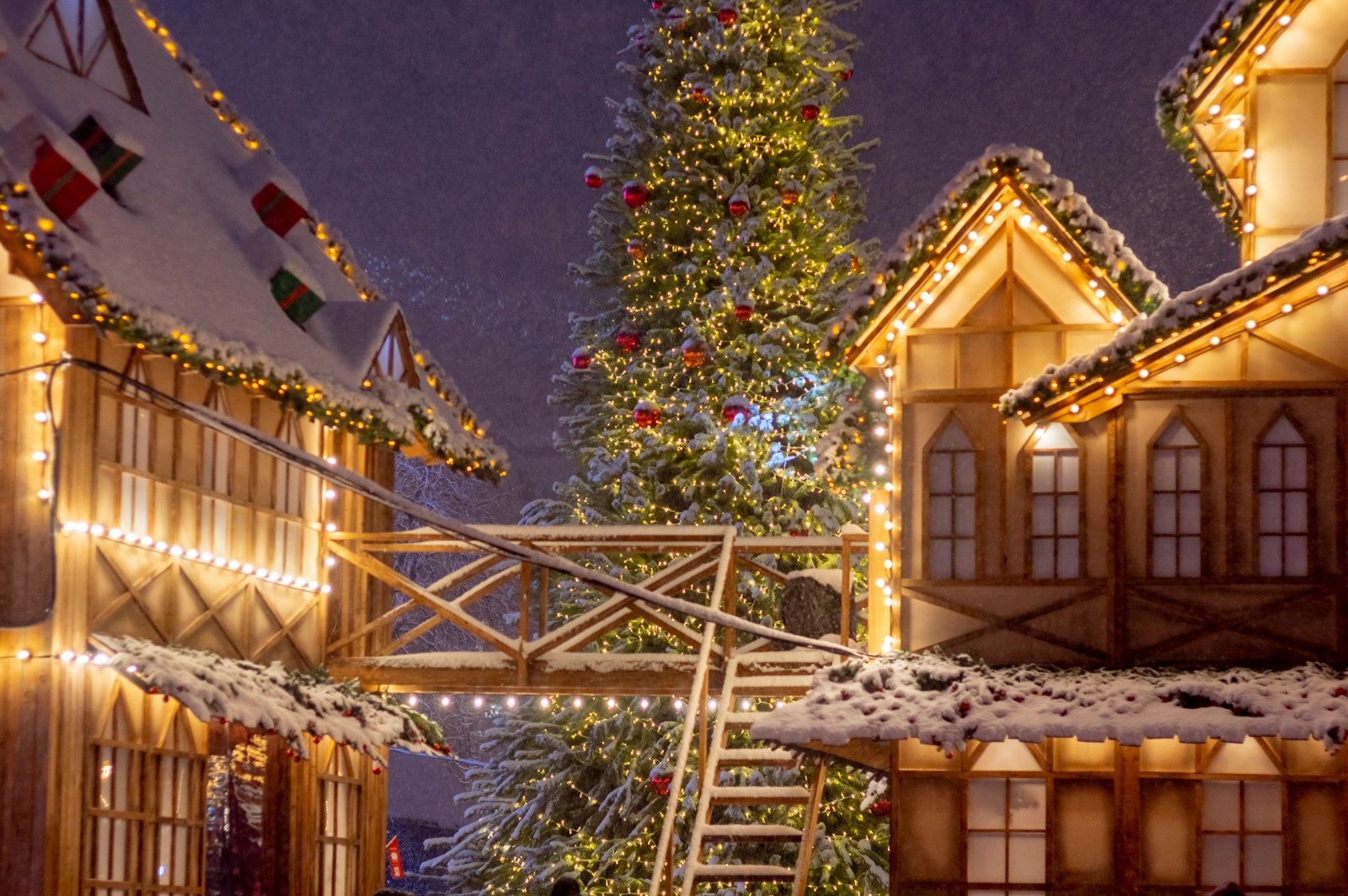Chiang Mai, located in the mountainous north of Thailand, is that city where one will equally discover the ancientness of tradition and feel in modernized comfort. Known as “the Rose of the North,” this city is packed with an enchanting blend of ancient temples, busy markets, lush countryside, and a unique cultural heritage that never fails to captivate a traveling visitor. Chiang Mai offers antique Thai temples, energetic markets, luxuriant landscapes, and an eccentric cultural inheritance that never fails to captivate visitors. Whether you aim at spiritual enlightenment, a journey of culinary discovery, or even heart-pumping outdoor activities, Chiang Mai promises you an adventure like none other.
This elaborative guide comprises everything that one needs to know when visiting Chiang Mai, including things to do in Chiang Mai, accommodation options, local food, means of transportation, and many more. The guide shall be very important as it equips you with everything that may be needed for smooth and enjoyable trips to Chiang Mai.

Essential Travel Information
Visa Requirements:
Most nationalities are allowed to enter Thailand visa-free and stay for 30 days. However, if you plan to stay longer, you may have to apply for a visa before traveling or extend your current visa in Thailand. It is best to check current visa requirements with the Thai embassy or consulate in your country.
Safety Tips:
Generally, Chiang Mai is a very safe city for tourists. However, it always pays to be aware, especially in crowded areas such as markets. Keep your belongings secure, avoid carrying large sums of money around, and be conscious of traffic if you are walking or renting a scooter.
Cultural Etiquette:
Respect towards Thai culture is called for. Dress modestly when you visit temples, and cover your shoulders and knees. Take off your shoes whenever you enter a temple or somebody’s home. Avoid touching people’s heads since it is considered a very sacred organ of the body according to Thai culture.
Comprehensive Guide to Chiang Mai’s Attractions
Top Must-See Attractions:
Check out the top things to do in Chiang Mai:
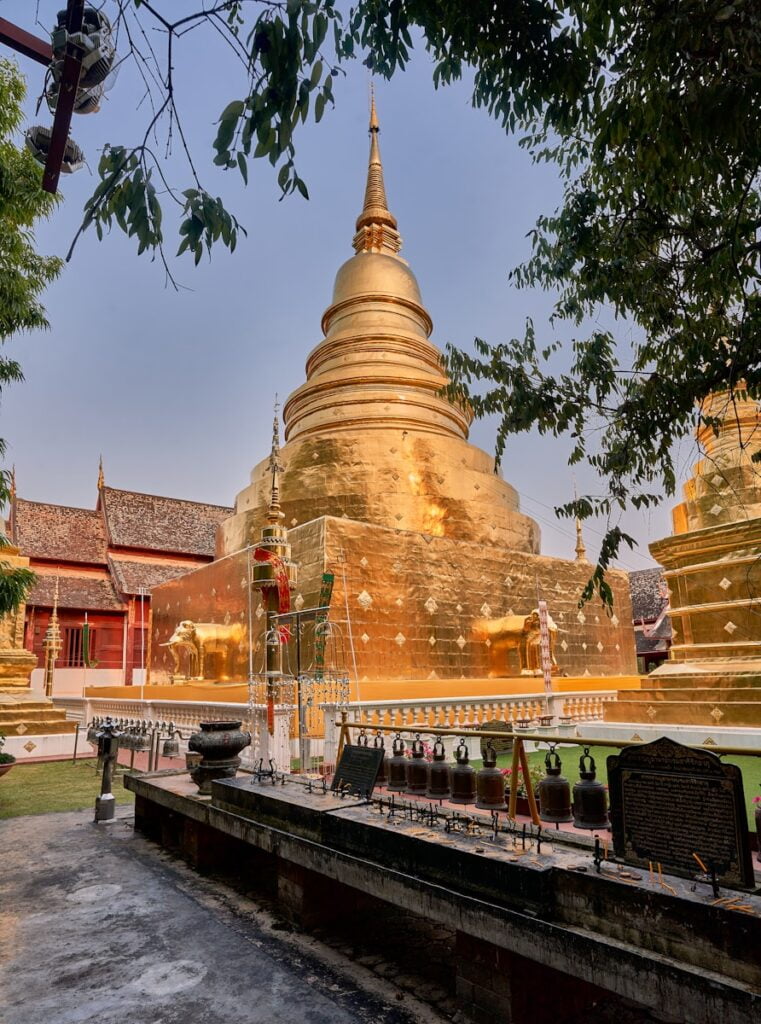
- Wat Phra That Doi Suthep:
Perched on a mountain overlooking the city, Wat Phra That Doi Suthep is Chiang Mai’s most iconic temple. The journey to the temple involves climbing a 300-step staircase flanked by intricately designed naga (serpent) statues. Once at the top, you’re rewarded with breathtaking views of Chiang Mai and the surrounding mountains. The temple itself is adorned with stunning gold accents, and the central chedi is a must-see for its intricate craftsmanship. - Elephant Nature Park:
A visit to the Elephant Nature Park offers a unique opportunity to interact with these gentle giants in an ethical and humane environment. The park is a sanctuary for rescued elephants, where you can learn about their stories and the conservation efforts in place to protect them. Unlike other attractions, this park focuses on the well-being of the elephants, allowing visitors to feed and bathe them without riding. - Old City Temples:
Chiang Mai’s Old City is a treasure trove of ancient temples, each with its own unique history and architecture. Wat Chedi Luang, with its towering, partially ruined chedi, and Wat Phra Singh, known for its exquisite Lanna-style architecture, are among the must-visit temples within the city walls.
Hidden Gems:
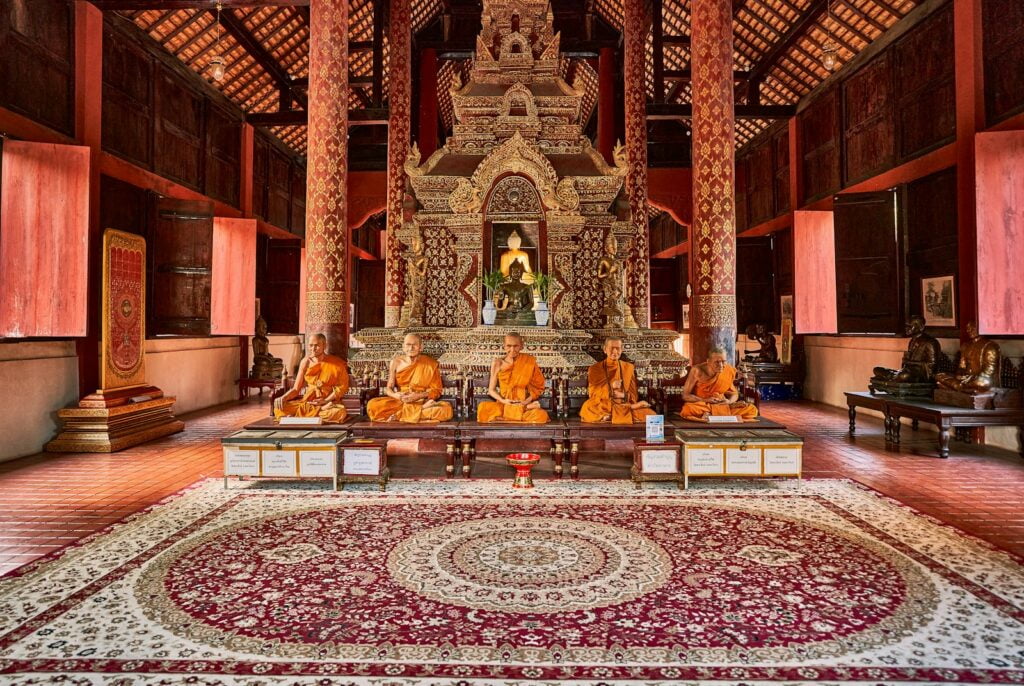
- Wat Umong:
For a more serene and off-the-beaten-path experience, visit Wat Umong, a forest temple located just outside the Old City. This temple is known for its peaceful atmosphere, underground tunnels, and ancient Buddha images. It’s a perfect spot for quiet contemplation and meditation. - Bua Thong Sticky Waterfalls:
Located about an hour’s drive from Chiang Mai, the Bua Thong Sticky Waterfalls are a natural wonder. The limestone rocks are surprisingly “sticky,” allowing you to climb up the falls without slipping. This hidden gem offers a refreshing escape from the heat and a fun adventure for all ages.
Seasonal Events and Festivals:
- Yi Peng Lantern Festival:
Held in November, the Yi Peng Lantern Festival is one of Chiang Mai’s most magical events. Thousands of lanterns are released into the sky, creating a breathtaking spectacle of lights. The festival coincides with Loy Krathong, where people float decorated baskets on the river as an offering to the water spirits. - Songkran (Thai New Year):
Songkran, celebrated in April, is Thailand’s New Year festival and is famous for its massive water fights. In Chiang Mai, the celebrations are particularly vibrant, with locals and tourists alike joining in the fun. The city’s moat becomes the central battleground, where everyone armed with water guns is a target.
In-Depth Accommodation Guide
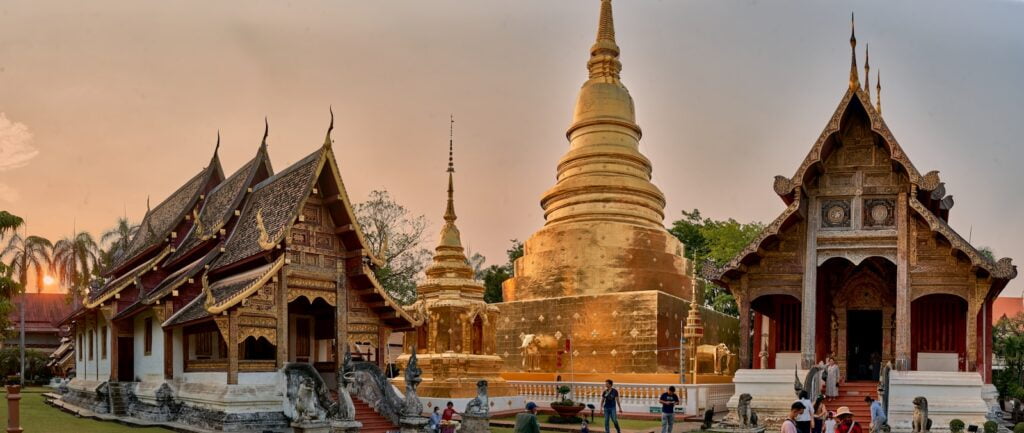
Luxury Stays:
- 137 Pillars House:
This luxury boutique hotel offers an elegant blend of colonial charm and modern amenities. Located in a quiet area near the Ping River, 137 Pillars House features spacious suites with private balconies, a stunning pool, and a spa that promises ultimate relaxation. It’s an ideal choice for travelers seeking a peaceful retreat with easy access to the city’s attractions. - Shangri-La Hotel Chiang Mai:
Located in the heart of Chiang Mai, the Shangri-La Hotel offers a luxurious stay with its world-class facilities, including a large outdoor pool, multiple dining options, and a spa. The rooms are elegantly designed, offering panoramic views of the city or the Doi Suthep mountain.
Budget-Friendly Options:
- Deejai Backpackers:
A popular choice among budget travelers, Deejai Backpackers offers affordable dormitory and private rooms in a lively, social atmosphere. The hostel features a pool, a communal kitchen, and regular social events, making it easy to meet fellow travelers. - The Common Hostel:
This modern, minimalist hostel is located in the Old City and offers clean, comfortable rooms at a great price. The Common Hostel is known for its friendly staff, free breakfast, and convenient location within walking distance of many attractions.
Read more: The 11 Best Hostels in Chiang Mai
Unique Stays:
- Treehouse Hideaway:
For a truly unique experience, consider staying in a treehouse in the nearby mountains. Several eco-resorts around Chiang Mai offer treehouse accommodations, where you can wake up to the sounds of nature and enjoy stunning views of the forest. - Chai Lai Orchid:
This eco-friendly lodge is more than just a place to stay—it’s also a social enterprise that supports local communities and elephant conservation. Guests can stay in bamboo huts along the river, interact with elephants, and participate in eco-friendly activities.
Neighborhood Guide:
- Old City:
The Old City is the heart of Chiang Mai and is surrounded by ancient walls and a moat. It’s home to numerous temples, markets, and historical sites, making it the perfect base for first-time visitors. The area is also packed with cafes, restaurants, and budget accommodations. - Nimmanhaemin Road:
Often referred to as the “hip” side of Chiang Mai, Nimmanhaemin Road is known for its trendy cafes, boutique shops, and vibrant nightlife. It’s a great area for those who enjoy a more modern, cosmopolitan vibe. - Riverside:
The Riverside area along the Ping River offers a quieter, more laid-back atmosphere. It’s home to several luxury hotels and riverside restaurants, making it a great choice for those seeking a more relaxed stay with beautiful views.
I am recommending places to stay at the best hotels in Chiang Mai.
Local Cuisine and Dining Recommendations
Introduction to Northern Thai Cuisine:
Chiang Mai is the culinary capital of northern Thailand, and its cuisine is distinct from what you’ll find in Bangkok or the southern regions. Northern Thai food is characterized by its use of fresh herbs, spicy chilies, and rich flavors. Dishes are often served with sticky rice, which is eaten with your hands.

Top Restaurants and Street Food Spots:
- Khao Soi Khun Yai:
Khao Soi is a must-try dish when in Chiang Mai, and Khao Soi Khun Yai is one of the best places to try it. This small, unassuming restaurant is famous for its rich, creamy khao soi, a coconut curry noodle soup topped with crispy noodles and served with pickled vegetables. - Saturday Walking Street Market:
Chiang Mai’s street food scene is vibrant and diverse, and the Saturday Walking Street Market is one of the best places to sample local delicacies. Try sai ua (northern Thai sausage), kanom krok (coconut pancakes), and mango sticky rice as you stroll through the market.
Vegetarian and Vegan Options:
- Free Bird Cafe:
A popular spot among vegetarian and vegan travelers, Free Bird Cafe serves delicious plant-based dishes with a focus on organic, locally sourced ingredients. The cafe also supports local charities, so your meal will contribute to a good cause. - Anchan Vegetarian Restaurant:
Located near Nimmanhaemin Road, Anchan Vegetarian Restaurant offers a wide range of Thai and international vegetarian dishes. The menu changes regularly based on the availability of fresh ingredients.
Food Tours and Cooking Classes:
- Chiang Mai Food Tours:
For a guided culinary experience, consider joining a food tour that takes you to the city’s best local eateries. Chiang Mai Food Tours offers several options, including street food tours, market tours, and private tours tailored to your preferences. - Thai Farm Cooking School:
Learn to cook traditional Thai dishes at the Thai Farm Cooking School, located just outside the city. The class includes a visit to a local market, where you’ll buy fresh ingredients, and a hands-on cooking session where you’ll prepare several dishes.
How to Get Around Chiang Mai
Public Transportation:
Chiang Mai’s public transportation system primarily consists of songthaews, tuk-tuks, and local buses. Songthaews, which are red pickup trucks converted into shared taxis, are the most common and affordable way to get around. They follow set routes but can also be hired for private rides. Tuk-tuks, while slightly more expensive, offer a faster and more direct way to travel short distances. Buses are less common among tourists but can be useful for specific routes, such as from the airport to the city center.
Renting Scooters and Bicycles:
For more freedom and flexibility, renting a scooter is a popular option. Scooter rentals are widely available throughout Chiang Mai, with daily rates ranging from 150 to 300 THB. However, it’s important to exercise caution—always wear a helmet, carry an international driver’s license, and be aware of the local traffic laws. Alternatively, renting a bicycle is an eco-friendly way to explore the city, especially the flat areas of the Old City and nearby neighborhoods.
Walking Tours:
Chiang Mai’s compact size and walkable streets make it an ideal city to explore on foot. Several walking tours are available, focusing on different themes such as historical sites, food, or culture. Walking allows you to discover hidden gems, interact with locals, and immerse yourself in the city’s unique atmosphere. Notable walking routes include a temple tour of the Old City and a market tour of Warorot Market.
Day Trips and Excursions
Popular Day Trips:
- Chiang Rai:
A day trip to Chiang Rai is a must for those interested in exploring more of northern Thailand’s cultural treasures. The city is home to the stunning White Temple (Wat Rong Khun), the intricately designed Blue Temple (Wat Rong Suea Ten), and the ancient ruins of Chiang Saen. Tours from Chiang Mai to Chiang Rai typically include visits to these sites, along with a stop at the Golden Triangle, where Thailand, Laos, and Myanmar meet. - Doi Inthanon National Park:
Doi Inthanon, the highest mountain in Thailand, is a popular destination for nature lovers and adventure seekers. The national park offers stunning landscapes, including waterfalls, hiking trails, and viewpoints. The most famous spots include the twin royal pagodas near the summit and the Wachirathan Waterfall. Guided tours from Chiang Mai often include transportation, entrance fees, and a knowledgeable guide. - Mae Sa Waterfall:
Located just a short drive from Chiang Mai, Mae Sa Waterfall is a multi-tiered waterfall nestled in a lush forest. It’s a great spot for a relaxing day in nature, with several picnic areas and easy hiking trails. The waterfall is part of the larger Mae Sa Valley, which is home to several other attractions such as the Mae Sa Elephant Camp and Queen Sirikit Botanic Garden.
Adventure Activities:
- Zip-Lining:
Chiang Mai is known for its thrilling zip-lining experiences, with several operators offering courses that take you through the lush jungle canopy. Flight of the Gibbon is one of the most popular providers, offering a well-maintained course with experienced guides. The zip-lining adventure includes a series of platforms, sky bridges, and abseiling points, allowing you to soar above the treetops and enjoy breathtaking views of the forest below. - Hiking and Trekking:
The surrounding mountains and national parks offer numerous hiking and trekking opportunities, ranging from short walks to multi-day treks. Popular routes include hikes to Doi Suthep, the summit of Doi Inthanon, and the Mae Tang Valley. Guided treks often include visits to hill tribe villages, where you can learn about the local culture and way of life. - Jungle Treks:
For a more immersive experience, consider a multi-day jungle trek, which allows you to explore remote areas and stay overnight in hill tribe villages. These treks often include activities such as bamboo rafting, visiting waterfalls, and learning about the diverse flora and fauna of the region.
Cultural Tours:
- Hill Tribe Villages:
Chiang Mai is a gateway to the hill tribes of northern Thailand, including the Karen, Hmong, Lahu, and Akha. Visiting these villages offers a unique insight into the traditional ways of life that have been preserved for centuries. Several tours are available, ranging from day trips to multi-day experiences, where you can stay overnight in a village and participate in cultural activities such as weaving, cooking, and farming. - Handicraft Villages:
The areas around Chiang Mai are renowned for their traditional handicrafts, including pottery, silk weaving, silverwork, and umbrella making. A visit to the handicraft villages, such as Baan Tawai or Sankampaeng, offers a chance to see artisans at work and purchase unique souvenirs directly from the makers. Many tours include transportation and visits to several villages, allowing you to see a variety of crafts.
Shopping in Chiang Mai
Night Markets and Bazaars:
- Sunday Walking Street Market:
The Sunday Walking Street Market, held every Sunday evening in the Old City, is one of Chiang Mai’s most popular shopping destinations. The market stretches along Rachadamnoen Road and features hundreds of stalls selling everything from handmade crafts and clothing to street food and souvenirs. The market is also a hub for live performances, with local musicians and artists entertaining the crowds. - Warorot Market:
Located in the heart of Chiang Mai’s Chinatown, Warorot Market is a bustling market that offers a more local shopping experience. It’s the perfect place to shop for traditional Thai products such as spices, dried fruits, and textiles. The market is also known for its street food, offering a wide range of local snacks and dishes.
Handicrafts and Souvenirs:
- Silk and Textiles:
Northern Thailand is famous for its exquisite silk and textiles, which are often handmade using traditional methods. Several shops and markets in Chiang Mai sell high-quality silk scarves, shawls, and clothing. For a more authentic experience, visit the weaving villages in the surrounding area, where you can see the entire process from silk production to weaving. - Silverware:
Chiang Mai is also known for its fine silverware, with many artisans creating intricate jewelry, bowls, and decorative items. The Wualai Road area, known as the Silver District, is home to several silversmiths and shops where you can purchase unique pieces directly from the makers.
Shopping Malls and Boutiques:
- Maya Lifestyle Shopping Center:
For a more modern shopping experience, visit Maya Lifestyle Shopping Center, located near Nimmanhaemin Road. The mall offers a mix of international and local brands, along with a variety of dining options and a rooftop bar with panoramic views of the city. - One Nimman:
One Nimman is a stylish shopping complex that blends contemporary design with traditional Lanna architecture. It’s home to boutique shops, art galleries, and cafes, making it a great place to shop for unique, high-quality products.
Suggested Itineraries
3-Day Itinerary:
- Day 1:
- Morning: Explore the Old City, visiting temples such as Wat Phra Singh and Wat Chedi Luang.
- Afternoon: Head to Wat Phra That Doi Suthep for panoramic views of the city.
- Evening: Enjoy dinner at a local restaurant, followed by a visit to the Sunday Walking Street Market.
- Day 2:
- Morning: Visit the Elephant Nature Park for an ethical elephant experience.
- Afternoon: Relax at your hotel or explore the Nimmanhaemin Road area.
- Evening: Dine at a rooftop restaurant with views of Doi Suthep.
- Day 3:
- Morning: Take a day trip to the Bua Thong Sticky Waterfalls.
- Afternoon: Visit the Queen Sirikit Botanic Garden or the Mae Sa Elephant Camp.
- Evening: Enjoy a traditional Khantoke dinner and cultural show.
I recommend you read this guide: 3 Days in Chiang Mai: A Cultural Journey
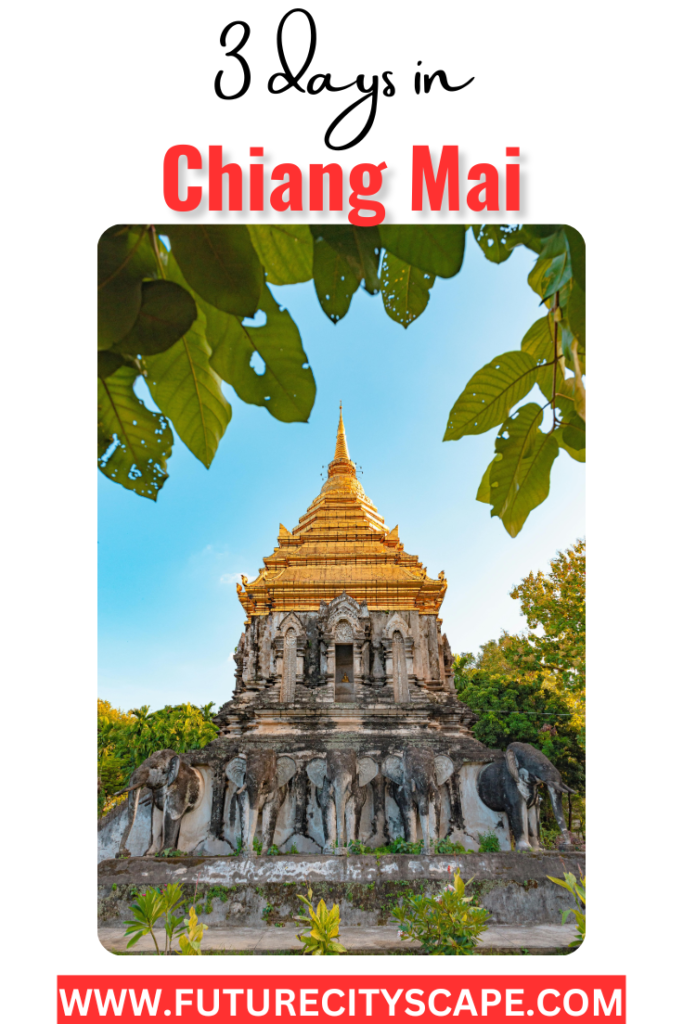
7-Day Itinerary:
- Day 1-3: Follow the 3-day itinerary above.
- Day 4: Take a day trip to Chiang Rai, visiting the White Temple, Blue Temple, and the Golden Triangle.
- Day 5: Explore Doi Inthanon National Park, hiking to the summit and visiting the twin royal pagodas.
- Day 6: Discover Chiang Mai’s handicraft villages, shopping for silk, silverware, and other traditional products.
- Day 7: Enjoy a cooking class at a local cooking school, followed by a relaxing spa day.
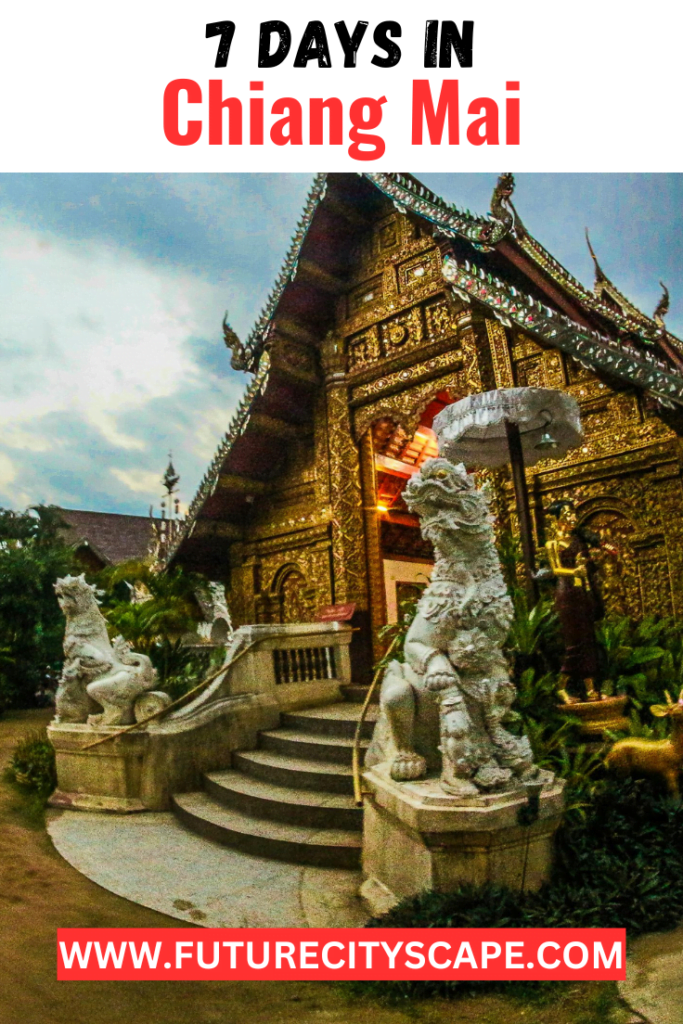
Special Interest Itineraries:
- For Food Lovers:
- Start your day with a local breakfast at a street food stall, followed by a food tour of the city’s best eats.
- Spend the afternoon at a cooking class, learning to prepare traditional Thai dishes.
- In the evening, dine at one of Chiang Mai’s top restaurants, and end the night with a visit to a night market for dessert.
- For History Buffs:
- Spend a full day exploring the Old City, visiting the major temples and historical sites.
- Take a guided tour to Chiang Saen, an ancient city located on the banks of the Mekong River, and visit the nearby temples and ruins.
- End your trip with a visit to the Lanna Folklife Museum to learn more about the region’s history and culture.
Practical Tips for Traveling in Chiang Mai
Best Time to Visit:
The best time to visit Chiang Mai is during the cool season, from November to February, when the weather is most pleasant. During this time, the temperatures are mild, ranging from 15°C to 28°C, and the skies are clear, making it perfect for outdoor activities and sightseeing. This period also coincides with some of Chiang Mai’s most vibrant festivals, such as the Yi Peng Lantern Festival in November and the Flower Festival in February.
The hot season, from March to May, can be quite uncomfortable, with temperatures soaring above 35°C. However, if you can handle the heat, this period offers fewer crowds and lower accommodation prices. The rainy season, from June to October, sees regular afternoon showers and occasional downpours. While the rain can be a deterrent, it’s also when the surrounding countryside is at its greenest, and waterfalls are at their most impressive.
Money and Budgeting:
Chiang Mai is an affordable destination, especially compared to other popular Thai cities like Bangkok or Phuket. Here’s a rough estimate of daily expenses:
- Budget Travelers:
- Accommodation: 200-600 THB (dormitory bed or budget guesthouse)
- Meals: 100-300 THB (street food and local restaurants)
- Transportation: 50-150 THB (public transport and short tuk-tuk rides)
- Activities: 300-600 THB (temple visits, walking tours)
- Mid-Range Travelers:
- Accommodation: 800-2000 THB (3-star hotel or boutique guesthouse)
- Meals: 300-600 THB (sit-down restaurants)
- Transportation: 100-300 THB (tuk-tuks, songthaews, or scooter rental)
- Activities: 600-1200 THB (guided tours, cooking classes)
- Luxury Travelers:
- Accommodation: 3000-10,000+ THB (luxury hotel or resort)
- Meals: 600-1500 THB (high-end restaurants)
- Transportation: 300-1000 THB (private car hire or guided tours)
- Activities: 1000-3000+ THB (private tours, spa treatments)
ATMs are widely available throughout the city, and most accept international cards. However, it’s advisable to carry some cash, especially when visiting markets or smaller establishments that may not accept credit cards. Currency exchange services are also readily available, with competitive rates in the Old City and Nimmanhaemin areas.
Read more: How can I travel the world alone? Solo Travel in Budget-Friendly
Language Tips:
While English is widely spoken in tourist areas, learning a few basic Thai phrases can enhance your experience and show respect for the local culture. Here are some useful phrases:
- Hello/Goodbye: Sawasdee (สวัสดี) – Say with a smile, adding “khrap” (ครับ) for men and “kha” (ค่ะ) for women.
- Thank you: Khop khun (ขอบคุณ)
- Yes: Chai (ใช่)
- No: Mai chai (ไม่ใช่)
- How much?: Thao rai? (เท่าไหร่?)
- Delicious: Aroy (อร่อย)
- Where is the restroom?: Hong nam yoo tee nai? (ห้องน้ำอยู่ที่ไหน?)
Even a simple “sawasdee” can go a long way in making connections with locals, and they’ll appreciate your effort to communicate in their language.
Conclusion
From ancient temples, colorful and vibrant festivals, culture to nature-it’s all here for every kind of traveler when it comes to Chiang Mai. Needless to say, this is going to be one heck of an experience. With this guide, one will be perfectly prepared to experience Chiang Mai like a professional-finding hidden corners and having truly lived a local life.
This book must guide you on whichever journey you would have made to Chiang Mai based on wide coverage and practical tips to ensure that your trip is both memorable and headache-free. Catch a view of the setting sun up on Doi Suthep, enjoy a delicious bowl of khao soi, or simply take a ride down the charming streets as you move from place to place in the Rose of the North.
I also noticed, while we were talking about beautiful building designs, that The Decor Blueprint, a blog specializing in interior design and decoration, provides interesting content.


